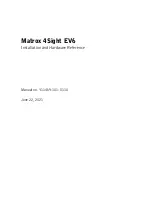
TROUBLESHOOTING
_________________________________________________________________________________________________________
5-1
COM-00-21-03 OCTOBER 2021
Version No.: A
SECTION 5
TROUBLESHOOTING
5
TROUBLESHOOTING
If properly configured, the Remote Station (RS) and the Base Station (BS) should connect within
one minute after being turned on. If the connection is not established, then the following needs
to be investigated.
Table 5-1 Troubleshooting Matrix
PROBLEM
TROUBLESHOOTING PROCEDURE
Configuration Mismatch
Verify that both the BS and the RS are configured for the same
configuration. (Note that if the configuration is to be changed over
the radio link, then it is essential to configure all RS units before
configuring the BS unit as connectivity to the RS unit will be lost
after the new configuration is implemented on the BS.)
Symbolic Link: It is important to note that the system relies on
symbolic links to the desired configuration file. Multiple
configurations can be stored on each radio, but only the one linked
is active. If the symbolic link is to the wrong configuration file, then
the unit will not connect.
Excessive Pathloss
In a lab setup, verify that the attenuation between the BS and the
RS is set properly and does not exceed 90 dB. (Do not power on
the radios without the proper attenuation between the units).
In an operational environment, verify that the path loss is
acceptable and that the connections to the antennas are secure
and proper. Verify that the antennas are correctly installed per the
RF plan.
Cabling & Antennas
Verify that both the BS and RS along with their associated RF cabling and
antennas are properly grounded.
Interference
Perform an RF scan using Apollo to verify that the channel is clear
of RF interference. Note that the radio has a very large RF range
and as such, out of TX/RX band RF energy can affect the radio’s
sensitivity. Proper use of external filters can reduce this
interference.
















































